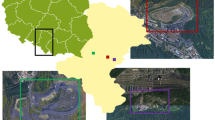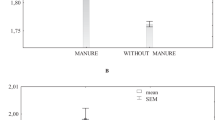Abstract
IN some calcareous grassland soils in County Galway, certain fertility problems have been encountered with particular regard to soil phosphorus. While ‘high’ or ‘very high’ values for readily soluble phosphorus were sometimes obtained by routine analytical procedures2, grazing and botanical observations indicated extreme phosphorus deficiency. Such observations were verified by herbage analyses, where figures of the order of 0.10–0.11 per cent of the dry matter were obtained.
This is a preview of subscription content, access via your institution
Access options
Subscribe to this journal
Receive 51 print issues and online access
$199.00 per year
only $3.90 per issue
Buy this article
- Purchase on Springer Link
- Instant access to full article PDF
Prices may be subject to local taxes which are calculated during checkout
Similar content being viewed by others
References
Muir, J. W., The Analyst, 77, 313 (1952). Walsh, T., Ryan, P. F., and McDonnell, J. J., Trans. Int. Soc. Soil Science (Dublin), 2 (1952).
Author information
Authors and Affiliations
Rights and permissions
About this article
Cite this article
McDONNELL, P. Interference in Soil Phosphorus Analyses by Snail Shells. Nature 180, 90–91 (1957). https://doi.org/10.1038/180090b0
Issue Date:
DOI: https://doi.org/10.1038/180090b0
Comments
By submitting a comment you agree to abide by our Terms and Community Guidelines. If you find something abusive or that does not comply with our terms or guidelines please flag it as inappropriate.



